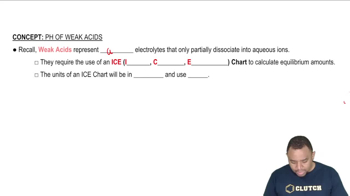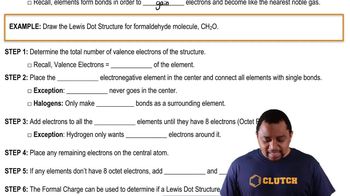A 1.0-L buffer solution initially contains 0.25 mol of NH3 and 0.25 mol of NH4Cl. In order to adjust the buffer pH to 8.75, should you add NaOH or HCl to the buffer mixture? What mass of the correct reagent should you add?
Ch.18 - Aqueous Ionic Equilibrium

Chapter 18, Problem 121
A 0.25-mol sample of a weak acid with an unknown pKa was combined with 10.0 mL of 3.00 M KOH, and the resulting solution was diluted to 1.500 L. The measured pH of the solution was 3.85. What is the pKa of the weak acid?
 Verified step by step guidance
Verified step by step guidance1
Calculate the moles of KOH added using the formula: \( \text{moles of KOH} = \text{volume (L)} \times \text{concentration (M)} \).
Determine the moles of the weak acid that reacted with KOH by subtracting the moles of KOH from the initial moles of the weak acid.
Calculate the concentration of the conjugate base formed by dividing the moles of the conjugate base by the total volume of the solution (1.500 L).
Use the Henderson-Hasselbalch equation: \( \text{pH} = \text{pKa} + \log \left( \frac{[\text{A}^-]}{[\text{HA}]} \right) \) to solve for pKa, where \([\text{A}^-]\) is the concentration of the conjugate base and \([\text{HA}]\) is the concentration of the weak acid.
Rearrange the Henderson-Hasselbalch equation to solve for pKa: \( \text{pKa} = \text{pH} - \log \left( \frac{[\text{A}^-]}{[\text{HA}]} \right) \).
Key Concepts
Here are the essential concepts you must grasp in order to answer the question correctly.
Weak Acids and pKa
Weak acids are substances that partially dissociate in solution, establishing an equilibrium between the undissociated acid and its ions. The pKa is a measure of the strength of an acid, defined as the negative logarithm of its acid dissociation constant (Ka). A lower pKa value indicates a stronger weak acid, while a higher pKa indicates a weaker acid.
Recommended video:
Guided course

ICE Charts of Weak Acids
Neutralization Reaction
A neutralization reaction occurs when an acid reacts with a base to form water and a salt. In this case, the weak acid reacts with KOH, a strong base, to produce water and the conjugate base of the weak acid. The stoichiometry of the reaction is crucial for determining the concentrations of the species present after the reaction.
Recommended video:
Guided course

Lewis Dot Structures: Neutral Compounds
Henderson-Hasselbalch Equation
The Henderson-Hasselbalch equation relates the pH of a solution to the pKa of the acid and the ratio of the concentrations of the conjugate base to the acid. It is expressed as pH = pKa + log([A-]/[HA]). This equation is particularly useful for calculating the pKa of a weak acid when the pH and concentrations of the acid and its conjugate base are known.
Recommended video:
Guided course

Henderson-Hasselbalch Equation
Related Practice
Textbook Question
Textbook Question
In analytical chemistry, bases used for titrations must often be standardized; that is, their concentration must be precisely determined. Standardization of sodium hydroxide solutions can be accomplished by titrating potassium hydrogen phthalate (KHC8H4O4), also known as KHP, with the NaOH solution to be standardized. b. The titration of 0.5527 g of KHP required 25.87 mL of an NaOH solution to reach the equivalence point. What is the concentration of the NaOH solution?
Textbook Question
A 5.55-g sample of a weak acid with Ka = 1.3⨉10-4 was combined with 5.00 mL of 6.00 M NaOH, and the resulting solution was diluted to 750.0 mL. The measured pH of the solution was 4.25. What is the molar mass of the weak acid?
